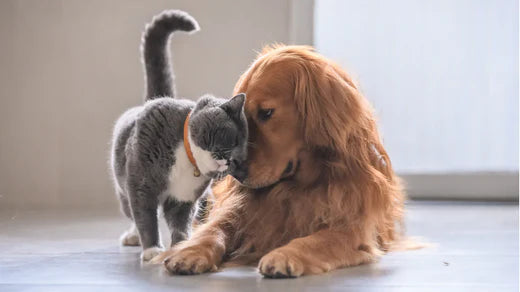
How to Interpret Your Pet's Behavior
Share
As pet owners, we often find ourselves puzzled by our furry friends' behaviors. Whether it's a sudden burst of energy, a display of affection, or an unexpected act of defiance, understanding the psychology behind these actions can significantly enhance our relationship with our pets. Here’s a guide to interpreting your pet’s behavior and improving communication.
1. Body Language is Key
Just like humans, pets communicate through body language. For dogs, a wagging tail usually signifies happiness, while a lowered tail may indicate fear or submission. Cats, on the other hand, might show their mood through their ears and whiskers. Pay attention to these signals:
• Dogs: A relaxed body posture and wagging tail means they’re happy. If they’re growling or showing teeth, it’s time to give them space.
• Cats: An arched back and puffed-up fur indicate fear or aggression, while slow blinking can be a sign of trust.
2. Vocalizations Matter
Pets use vocalizations to express their feelings. Understanding what different sounds mean can help you respond appropriately.
• Dogs: Barking can mean anything from excitement to alertness. A high-pitched bark often indicates playfulness, while a low growl can signal discomfort or warning.
• Cats: Meowing can be a way for cats to communicate with humans. A persistent meow might mean they want attention or food.
3. Recognizing Stress Signals
Stress in pets can manifest in various ways. Recognizing these signs is crucial for their well-being.
• Dogs: Signs of stress may include excessive panting, drooling, or pacing. If your dog is hiding or has a tucked tail, they might be feeling anxious.
• Cats: Over-grooming, hiding, or aggressive behavior can indicate stress. Ensure your cat has a safe space to retreat when feeling overwhelmed.
4. Establishing Routine and Structure
Pets thrive on routine. Establishing a consistent schedule for feeding, walks, and playtime can help them feel secure and understood.
• Dogs benefit from regular exercise and mental stimulation. Incorporate training sessions and interactive toys into their daily routine.
• Cats enjoy playtime but also value their alone time. Providing scratching posts and climbing structures can help them feel more at home.
5. Building Trust Through Positive Reinforcement
Positive reinforcement is one of the most effective ways to communicate with your pet. Rewarding good behavior with treats or praise encourages them to repeat those actions.
• For dogs, use treats and verbal affirmations during training sessions to reinforce positive behavior.
• For cats, engage them with toys or treats when they exhibit desirable behavior, like using the litter box or scratching the right surfaces.
6. Understanding Individual Personalities
Just like people, pets have unique personalities. Some dogs are naturally more social, while others may be shy or reserved. Similarly, cats can range from affectionate lap sitters to independent explorers.
• Spend time observing your pet's preferences and behaviors. Tailor your interactions based on their personality to strengthen your bond.
Conclusion
Understanding your pet’s psychology is an ongoing journey that can deepen your relationship and enhance communication. By paying attention to body language, vocalizations, and individual personalities, you can create a harmonious environment where your pet feels loved and understood. Remember, patience and observation are key; the more you learn about your furry friend, the better you’ll be able to meet their needs and strengthen your bond!
